15 Types of Blackbirds in Missouri (With Pictures)
Last Updated on
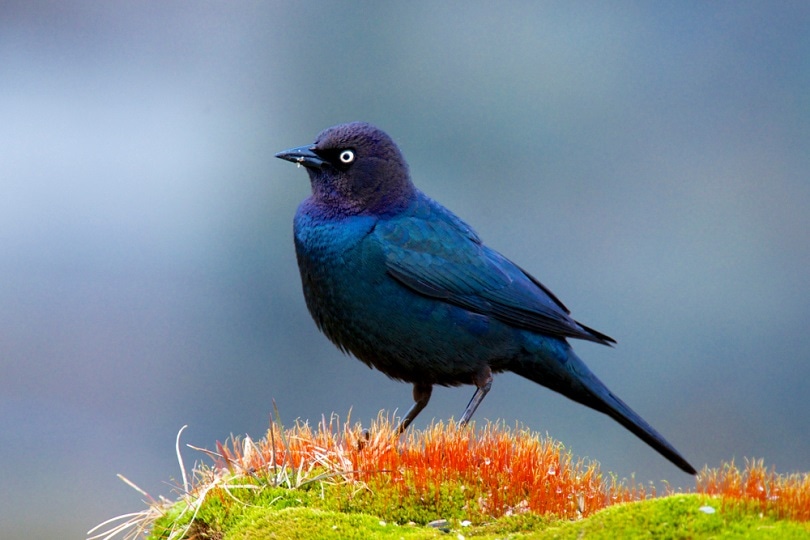
You can find blackbirds all across the world, and they’re definitely prevalent in many areas of North America. Midwestern states such as Missouri, Illinois, Ohio, and Indiana have dozens of different blackbird species flying through the regions at any given time of year, but particularly in the spring and summer months. During these months, temperatures are warmer, and food is more prevalent. But what types of blackbirds are most commonly found in Missouri? Let’s discuss.

The 15 Types of Blackbirds in Missouri
1. Eastern Meadowlark
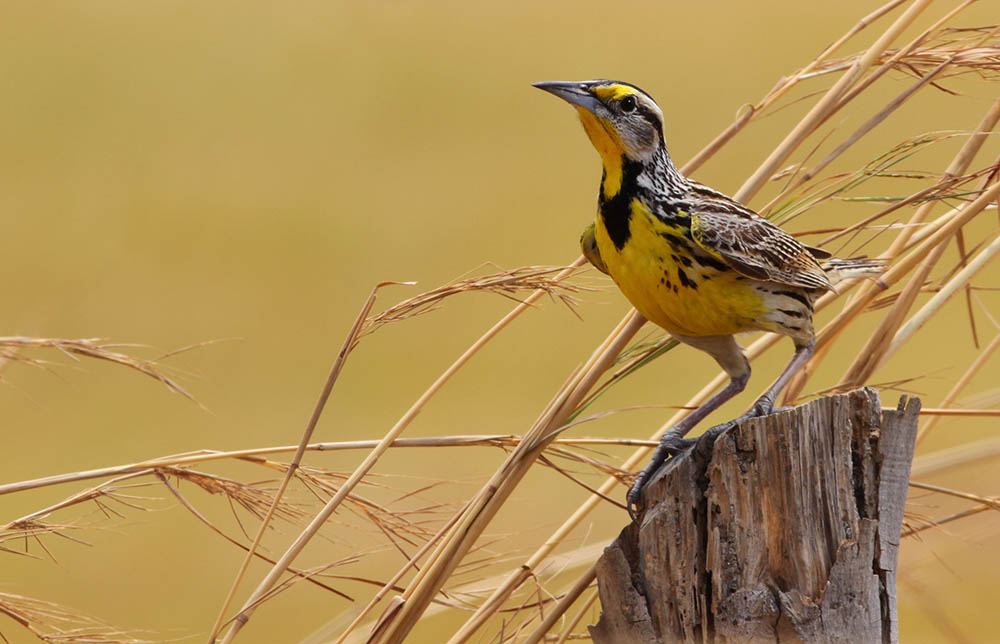
| Scientific name: | Sturnella magna |
| Weight: | 3.3-5.2 oz |
Eastern Meadowlarks are typically grouped with blackbirds, though their feathers have more of a gray appearance with black spots all over them. These birds have large round yellow bellies and a sash of yellow feathers on their throats. While many of them will migrate to the winter for the south, many will stay in the Missouri area or nearby states if they have enough food.
These beautiful songbirds are now listed on the endangered list and are usually found on the ground in large groups searching for seeds and insects including grasshoppers, true bugs, crickets, and beetles. They prefer to hang out in open fields or grasslands looking for food but will usually construct their nest in tree cavities and roofs that are high above the ground and made from grass and feathers.
2. Bullock’s Oriole

| Scientific name: | Icterus bullockii |
| Weight: | 1.0-1.5 oz |
Bullock’s Orioles are quite a sight to behold. They have mostly bright orange feathers, with black and white feathers on their back. Younger females tend to have a slightly grayish appearance with yellow tails and gray feathers on their heads and chest.
These birds are commonly found in States like Missouri and other Midwestern territories but can also be seen in southern states and even in Mexico. Bullock’s Orioles love to nest in parks and open woods foraging for fruit, nectar, and insects and you can attract them. Bullock’s Oriole sounds are a series of whistles and cheeps that last for a few seconds to your yard with jelly, sugar water, and fruit.
3. Yellow-headed Blackbird
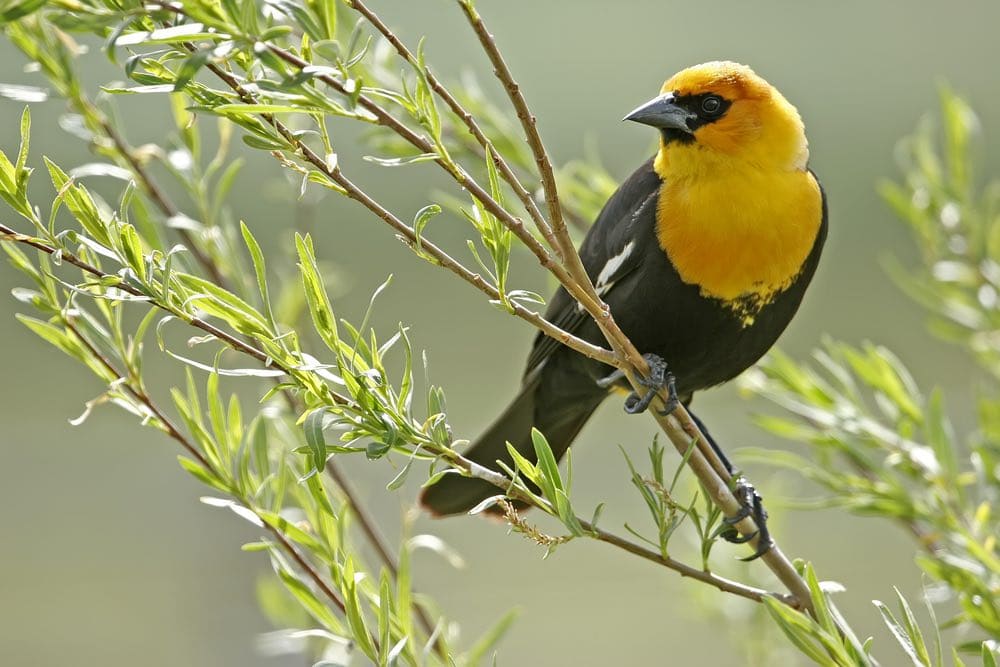
| Scientific name: | Xanthocephalus xanthocephalus |
| Weight: | 1.5-3.7 oz |
You may not find these birds as often as other blackbirds in Missouri, but they tend to hang around each season. These medium-sized birds have striking yellow feathers all over their head and neck and when the male birds open their wings you can see the white feathers on their bottoms.
Yellow-headed blackbirds are common in low wetlands and grasslands that have a lot of readily available food. They are prone to eating insects as well as seeds and grains in the winter months. In addition to Midwestern states like Missouri, you can also find these birds and Southwestern states such as Arizona and Mexico.
4. Orchard Oriole
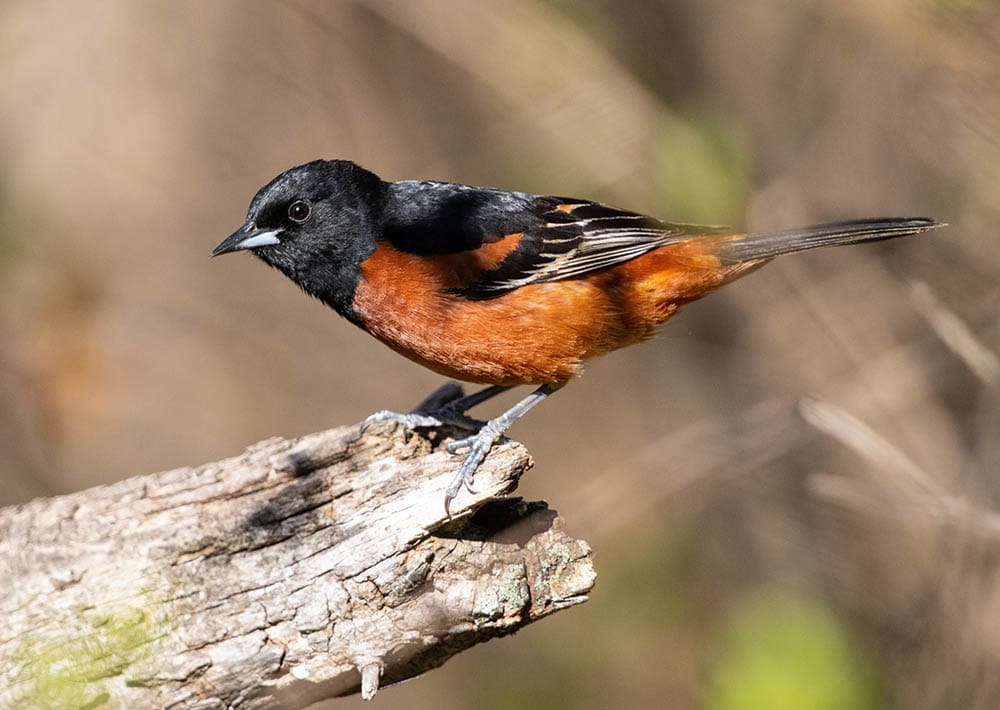
| Scientific name: | Icterus spurius |
| Weight: | 0.5-1.2 oz |
Orchard Orioles aren’t as commonly seen in Missouri as many other birds, but they can be found during their breeding season. You may also see these birds and nearby states such as Illinois and Ohio until they migrated South to areas including Central America and Mexico for the winter.
They’re small birds and the females are generally greenish-yellow, paler beneath, and darker on their backs. Male orioles have black backs, heads, and reddish undersides. Orchard Orioles prefer to hang out in open woodland areas.
They can usually be found around open shrubland, along riverbanks, and in farms and backyards. Orioles prefer to snack on mostly insects, including caterpillars and beetles as well as spiders. They also enjoy nectar from flowers and fruit including mulberries and chokeberries.
5. Brewer’s Blackbird
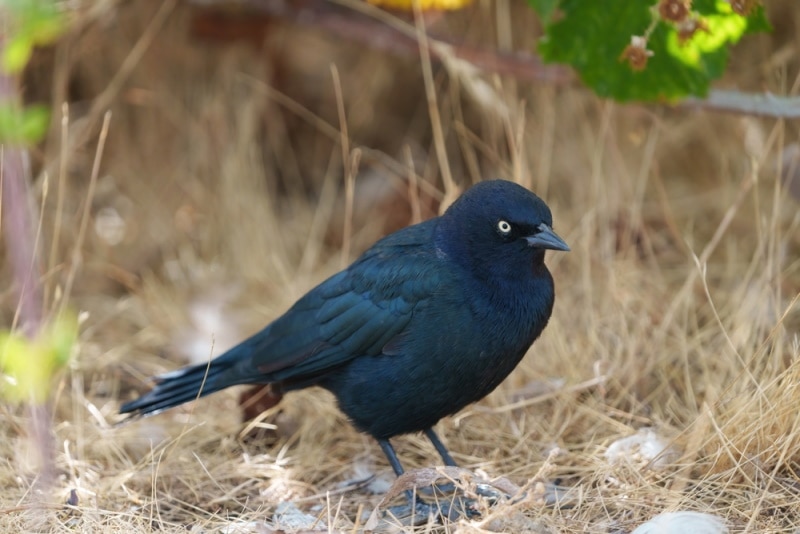
| Scientific name: | Euphagus cyanocephalus |
| Weight: | 1.6 -3.2 oz |
Here is another medium-sized black bird that is common in Missouri. They have slim purple heads and glossy black feathers. And in the sunlight, their feathers appear iridescent and even shades of green and brown. They are found not only in Missouri but in Northern Canada as well as eastern states.
These birds are commonly seen along coastlines and in woodland areas hiding out in tree cavities, though you may also spot them in state parks, backyards, and other areas where they can find insects, seeds, and grains. They are prone to staying in one spot, if food is sufficient, but may migrate to the south in the winter.
6. Rusty Blackbird
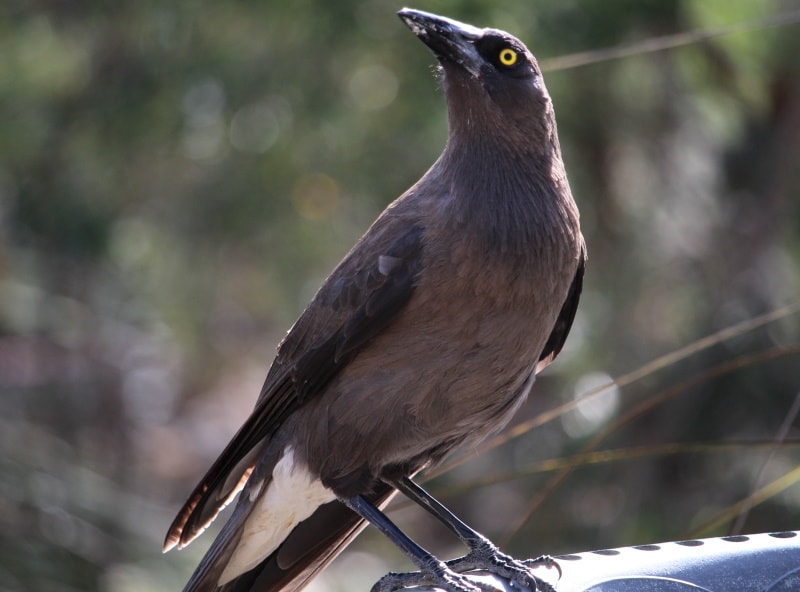
| Scientific name: | Euphagus carolinus |
| Weight: | 1.7-2.8 oz |
These black birds almost resemble small crows with their all-black feathers, round heads, and long bodies. They have black feathers that, depending on the way that the sun hits them, can appear to have blue, brown, purple, and gray tones.
The female birds are more grayish brown than black. They are common in midwestern states including Missouri, Illinois, and Ohio. They usually stay around in the warmer summer and spring months and tend to migrate in late September or early October.
Rusty Blackbirds can be found in moist regions of the state including swamps and bogs. They can also be found in wooded areas nesting in trees or shrubs or near water. Like many other blackbirds, these birds are omnivores and feed on insects, fruit, and nuts.
7. Bobolink

| Scientific name: | Dolichonyx oryzivorus |
| Weight: | 1.1-2.2 oz |
Bobolinks stand out from other blackbird species due to the large yellowish-white spot of feathers on the back of their heads. They have white backs and black bellies and long legs. The females have dark brown skin and dark eyes with stripes on their crowns.
They can often be seen in the eastern and midwestern states during migration seasons (September through April). These beautiful birds are often found on open grassland in the breeding season. After breeding, they are often found along coastal areas or in marshes.
You can find them perched on top of shrubs looking for small seeds or insects such as grasshoppers, caterpillars, or ants to feed their young. These birds often use tree cavities to build their nests, but you can also find many of their nests on the ground surprisingly. They love to hang out in grassy fields and meadows where wild fruits and random insects roam free.
8. Western Meadowlark
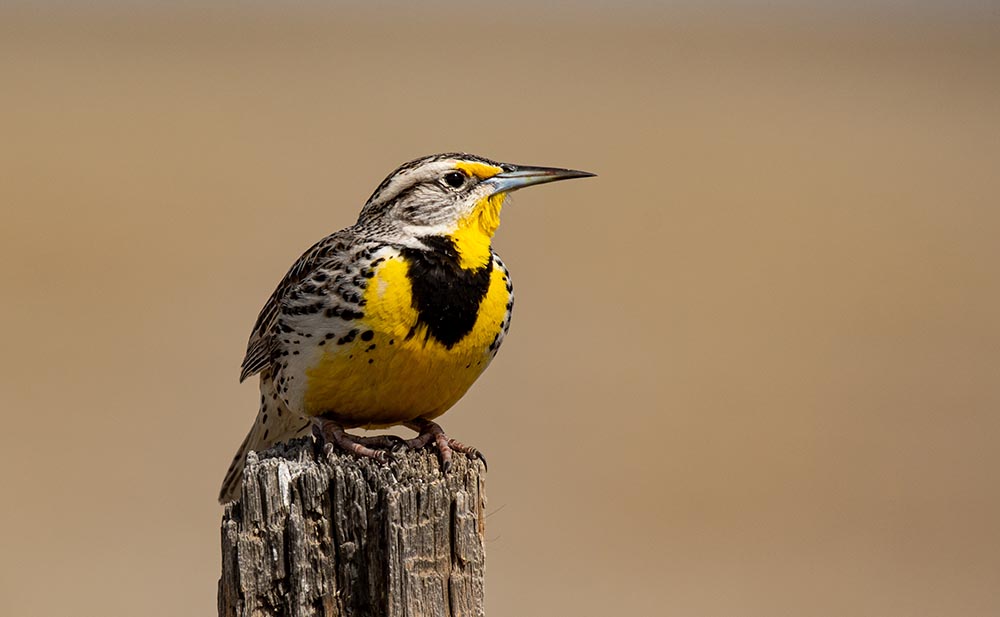
| Scientific name: | Sturnella neglecta |
| Weight: | 3.0-4.0 oz |
Western Meadowlarks are small birds that are more multi-colored than they are black, unlike many of the birds on this list. Most of their feathers have a grayish brown tint with black spots. However, they have bright yellow bellies which hang over their short skinny legs.
These birds happen to be the state bird for six different states. They are more commonly seen in the southern areas of the state and can be heard all throughout parks and open grasslands due to their melodious songs. These birds prefer warmer weather and will typically migrate during the winter months. You can usually find them in large groups foraging together looking for seeds and insects.
9. Scott’s Oriole

| Scientific name: | Icterus parisorum |
| Weight: | 1.0-1.5 oz |
Scott’s Orioles are medium to larger-sized blackbirds that have an interesting feather combination. Their bellies are yellow, their chest and back feathers are black, and their heads are black as well. However, they have yellow tail feathers that have black tips.
You will definitely recognize these birds instantly if you see them around the rural areas of Missouri. They are native to the US and Northern parts of Mexico where they will typically breed before heading south for the colder months of the year.
You can also find them in parts of Southern California and even Arizona. Scott’s Orioles can be found on high slopes in grassy regions, where they feed on fruit and small insects including butterflies, caterpillars, and beetles.
10. Great-tailed Grackle

| Scientific name: | Quiscalus mexicanus |
| Weight: | 3.5-6.8 oz |
Great-tailed Grackles could also be mistaken for crows if it wasn’t for their long black tails — which explains their name. These birds are tall and thin and have beautiful black taper tails that extend from their back about 3 to 4 inches.
The males have iridescent feathers and piercingly yellow eyes. The females are also long-legged, slender, and have yellow eyes. Great-tailed Grackles are found in the Midwest, west, and in many urban areas.
These beautiful birds eat grains, seeds, and fruits, along with insects and other animals like bees and spiders. Sometimes they will also munch on eggs and nestlings, as well as small lizards and mammals. They prefer to build nests high up in trees, made of weeds, grass, and small twigs.
11. European Starling

| Scientific name: | Sturnus vulgaris |
| Weight: | 2.0-3.3 oz |
Also commonly known as the “Common Starling” this bird is beautifully iridescent with black feathers that appear to have polka dot-like speckles all over the body and appear green, blue, gray, and purple. It’s a medium-sized bird that has a round stocky body. They may not be seen in Missouri as commonly as other birds, and they can also be found in areas of Canada and Alaska. Because of their aggressive behavior and large flock preferences, they’re often considered to be a nuisance.
They can be seen flying above fields or perched on top of trees in large groups eyeing the area for food. These medium-sized starlings will eat all kinds of insects including earthworms, beetles, caterpillars, earthworms, and spiders. They also enjoy fruit such as mulberries, cherries, holly, and wild blackberries.
12. Common Grackle
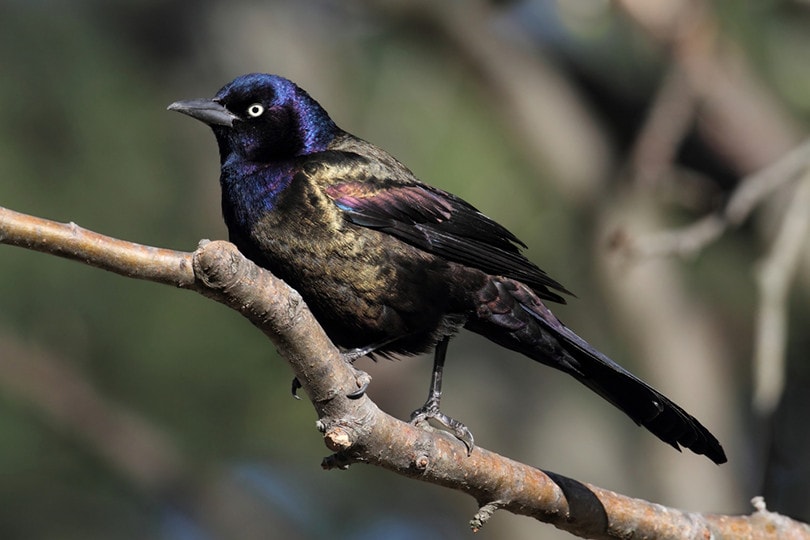
| Scientific name: | Quiscalus quiscula |
| Weight: | 2.5-5.3 oz |
The Common Grackle is another beautifully iridescent black bird that almost shines in the sunlight. Their spotted iridescent feathers make their bodies look like shiny shadows. They have long tails and are a bit taller than the average blackbird.
The feathers on the male birds are a bit shinier than those on the females, though both birds are about the same size. These birds are known to forage in large groups across the Midwest, southern states, and parts of Canada.
These grackles are also common in Illinois and Ohio and are considered a threatened species due to their declining numbers. Their habitat includes open woodlands and parks as well as fields and damp marshes. They’re known for munching on crops such as corn and grain, and they will also sift through the garbage.
13. Red-winged Blackbird
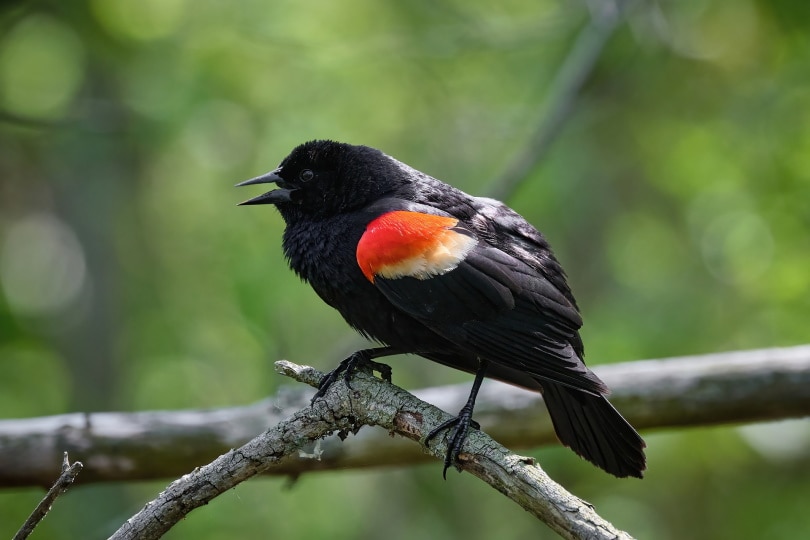
| Scientific name: | Agelaius Phoeniceus |
| Weight: | 1.0-2.8 oz |
The Red-winged Blackbird is renowned for its beautiful back feathers. These blackbirds are black all the way around with the exception of their back feathers which have reddish-orange and yellow spots (Which almost look like mini flags).
Like many other blackbirds, these medium-sized birds will stay in Missouri for the warmer summer and spring months then migrate south toward the end of September. The female blackbirds’ feathers are a bit duller than the males and have streaks of brown.
These birds can also be found in Northern parts of Canada and in other Midwestern states. They’re well known for aggressively defending their territories during mating season and building their nests (which consist of wet leaves and mud) rather quickly in areas of moist grassy meadows and fields.
14. Baltimore Oriole

| Scientific name: | Icterus galbula |
| Weight: | 1.0-1.3 oz |
The Baltimore Oriole is on the smaller side, but it has a large round belly and short skinny legs. Adult males have bright orange and black feathers, with white wings on their backs. The females are yellowish beneath and on their heads, with grayish brown on the wings.
These birds are agile, foragers, and are frequently found in backyards, state parks, and local forest preserves. They love to munch on insects such as crickets, Beatles, and caterpillars, but will also eat snails and spiders.
The Baltimore Orioles typically migrate to Florida, the Caribbean, and Central America in winter and will leave anywhere from late July to early September. They have a flute-like song that can be heard from several hundred feet away.
15. Brown-headed Cowbird
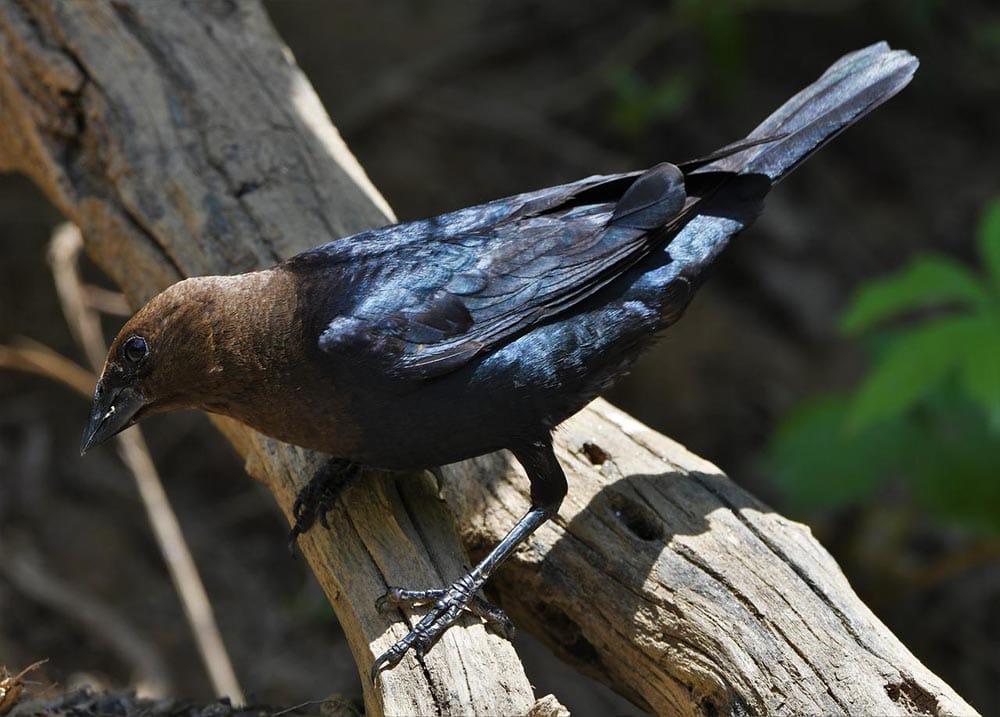
| Scientific name: | Molothrus ater |
| Weight: | 1.2-1.9 oz |
The Brown-headed Cowbird stands out due to its distinctive brown head, which almost looks like a hood on top of its dark gray feathers which are prevalent on its chest, back, and belly. The males of these round-bellied birds have a black body with a brown head and tail.
The females are smaller and gray-brown with slight streaking on their backs. You may not see these birds as often in Missouri but may catch them around the spring and summer months and in nearby states. They are also popular on the Pacific coasts and tend to migrate in the winter.
When in Missouri, you may find them in grasslands and open fields, but rarely are they located in wooded areas. These stocky birds prefer to stay close to the ground near grazing animals where they can sneakily snatch food. They also eat insects, weeds, and various seeds.

Wrapping Things Up
As you can see, there are numerous black birds that you may find all across the state of Missouri. You may commonly see these birds in the spring and summer months, as many will migrate to the south for the winter. And if you’re looking to attract them to your backyard, a simple open feeder with sunflower seeds, hulled white millet and shelled peanuts will usually do the trick. It’s important to consider the species of the bird, as some of the birds on this list can be a bit of a nuisance.
See Also: 15 Common Types of Sparrows in Missouri (With Pictures)
Featured Image Credit: Danita Delimont, Shutterstock
Table of Contents
- The 15 Types of Blackbirds in Missouri
- 1. Eastern Meadowlark
- 2. Bullock’s Oriole
- 3. Yellow-headed Blackbird
- 4. Orchard Oriole
- 5. Brewer’s Blackbird
- 6. Rusty Blackbird
- 7. Bobolink
- 8. Western Meadowlark
- 9. Scott’s Oriole
- 10. Great-tailed Grackle
- 11. European Starling
- 12. Common Grackle
- 13. Red-winged Blackbird
- 14. Baltimore Oriole
- 15. Brown-headed Cowbird
- Wrapping Things Up
About the Author Robert Sparks
Robert’s obsession with all things optical started early in life, when his optician father would bring home prototypes for Robert to play with. Nowadays, Robert is dedicated to helping others find the right optics for their needs. His hobbies include astronomy, astrophysics, and model building. Originally from Newark, NJ, he resides in Santa Fe, New Mexico, where the nighttime skies are filled with glittering stars.
Related Articles:
Monocular vs Telescope: Differences Explained (With Pictures)
10 Types of Hummingbirds in Arkansas (With Pictures)
8 Types of Hummingbirds in Nebraska (With Pictures)
5 Types of Hummingbirds in Idaho (With Pictures)
3 Types of Hummingbirds in Mississippi (With Pictures)
8 Types of Hummingbirds in Kansas (With Pictures)
5 Types of Hummingbirds in West Virginia (With Pictures)
5 Types of Hummingbirds in Ohio (With Pictures)
